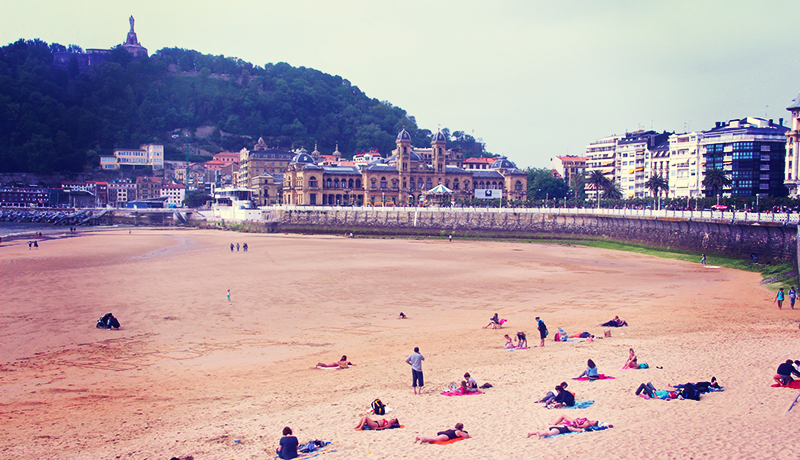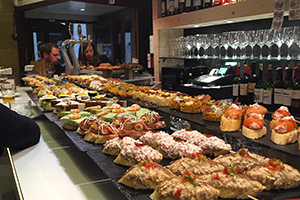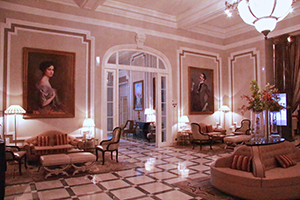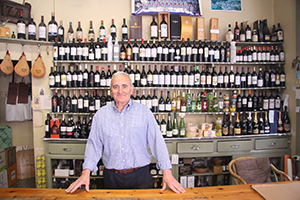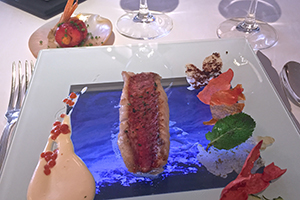
Not much is needed to experience two perfect days in San Sebastián, northern Spain’s dreamy coastal city. Forty-eight hours would be well spent lying languidly on its beaches, gazing into the serene turquoise Bay of Biscay and aimlessly strolling cobblestone streets while people-watching. It comes as no surprise that Spanish royalty and aristocrats summered in San Sebastián during its heyday, leaving their legacy behind in the ornate Belle Èpoque architectural stylings found across town.
And, of course, one cannot leave San Sebastián (known as Donostia in Basque) without enjoying its Basque cuisine. “It is a paradise for food,” says chef Elena Arzak, who runs the lauded Arzak with her father and creator of Nueva Cocina Vasca (New Basque cuisine), chef Juan Mari Arzak. “It’s very mixed between the local people who adore food and food lovers from all over the world,” Elena says. “There has been generated, in this area, a gastronomic tourism. If you come to San Sebastián, there are so many possibilities.” Read on for specifics on a few that involve a lot of eating and exploring.
Day One
Built in 1865, Hotel de Londres y de Inglaterra offers some of the best views in the city, from elegant rooms boasting private terraces with views of the sea to a quaint attic unit that overlooks the city. The historic boutique hotel looks out over the city’s most central beach, the appropriately named La Concha Bay, which cuddles against the coast like a shell.
After checking in, the best introduction to San Sebastián is a walk along el Paseo de la Concha, the promenade running beside the beach and lined with a white wrought-iron balustrade. Here, as with the rest of the town, locals and visitors commingle, enjoying the ocean view and sites like the decorative former Grand Casino (now City Hall) and a whimsical, turn-of-the-century carousel.
There are several spots that afford spectacular vistas and one is Monte Urgull, where the watchful statue of Christ towers over Parte Vieja (Old Town). Start at Plaza Zuloaga or Iglesia de Santa Maria and follow one of several meandering paths to the top for ideal photo ops.
Once you’ve worked up an appetite, head back down into the old part of town, where most of the city’s pintxo bars are concentrated. A cousin of the tapa, pintxos are bite-sized single servings often enjoyed with glasses of txakoli (a slightly effervescent Basque white wine) and sidre (tart Basque cider) while standing at the bar and socializing with friends. Most pintxos bars are open all day and some feature a sit-down restaurant in the back as well.
The early bird gets the worm at Bar Nestor, where those who know start lining up at noon for one of just 12 slices of the single tortilla de patata (potato omelet) that’s cut at 1 p.m. If you miss out, console yourself with a plate of its exceptional tomatoes drizzled with the highest quality olive oil, slices of piquant chorizo and tears of baguette. Bar La Cepa, opened in 1948, is one of the more historic restaurants in town. Enjoy a bocadillo de jamòn (razor-thin sliced Ibérico ham and melted Manchego on crusty bread) before heading next door for an ultra-creamy burnt Basque cheesecake at La Vińa.
For a relaxing afternoon, head back to the beach for a royal treatment at La Perla, a century-old spa overlooking the bay. Originally a bathhouse built for Queen Maria Cristina, La Perla now specializes in thalassotherapy (hydrotherapy using salt water), with features like waterbeds, sea vapor baths, dry saunas, cold seawater showers and a menu of face and body treatments.
After some pampering, stroll west on the Paseo de la Concha. Often bustling with tourists, performers and the occasional sand artist, Playa de la Concha becomes the more peaceful Playa de Ondarreta. At the end of the bay lies two of Elena Arzak’s favorite spots. Take the old-fashioned funicular railway up Monte Igueldo to the first one, an old amusement park with another beautiful view of San Sebastián from an entirely different perspective.
At the foot of Igueldo is the other, a steel creation titled El Peine del Viento (Comb of the Wind) by Basque sculptor Eduardo Chillida. Here, the waves of the Cantabrian Sea crash against the rocks and the sculptures imbedded in them. “When my children were born, I went there and took photos with them,” Elena says. “It’s something very special about San Sebastián.”
In an area of the world with some of the highest concentrations of globally recognized chefs per square mile, deciding on restaurants is a most difficult task. Akelarré, Martín Berasategui, Mugaritz and Etxebarri are just a few of the celebrated eateries serving innovative New Basque cuisine. But, when in San Sebastián, one must prioritize a visit to Arzak — though you’ll need to book far in advance to obtain seats here or any of the other top restaurants.
Before it was Arzak, the little house just 12 miles below the French border was a wine inn and tavern owned by Juan Mari’s grandparents. It transformed into a catering company run by his mother in the 1970s, when Juan Mari began experimenting with conceptual dishes that would become known as New Basque cuisine. Today, Juan Mari cooks with Elena, who was named Best Female Chef in the World in 2012.
“Everything has changed, but always with the Basque roots,” says Juan Mari, mentor to famed chef Ferran Adriá, of his constantly evolving avant-garde menu. “Most important for creativity is thinking like a child. Children always make everything in a different way.”
Arzak’s tasting menu could feature anything from graffiti-inspired eggs sprayed with parsley and squid ink to black pudding served on a crushed beer can, or red mullet- and herb-infused oak leaves presented on a clear plate that fit over a tablet playing a scene of the ocean tide.
Reminisce over your showstopper of a dining experience to the tune of mellow live music at Altxerri Jazz Club, tucked underneath Altxerri Galería, while sipping vermouth preparado or a gin tonica. Back at the hotel, admire the city’s lights shimmering on the water like a Van Gogh painting before sinking into the hotel’s plush mattress to prepare for another full day.
Day Two
Start your morning like a local by admiring the incredibly fresh bounty San Sebastián has to offer. Farmer’s market stands selling fruits, vegetables and flowers are found all over. La Bretxa, a market located underneath a shopping center in the old town, features more than 40 retailers peddling txistorra (fresh Basque chorizo), mountains of shiny anchovies and cod, and cases of cheeses like idiázabel and P’tit Basque.
“The Basque Country is special,” Juan Mari says. “People have taken a lot of care of the products. We like raw materials that are from this area because you can control the freshness and you know the suppliers. We respect the seasons and stay as sustainable as possible.”
Stop for a kaputxino (Basque for “cappuccino”) and pan con tomato (toast with tomato) at Koh Tao, a hip neighborhood coffee shop. Or for a more decadent (and decidedly more American) brunch spread, get a table at La Madame, a restaurant housed in an old brothel with options ranging from churros with dipping chocolate to eggs Benedict.
For a change of scenery, check in for a night (but book far in advance) at the grand Hotel Maria Cristina, the crown jewel of the Belle Èpoque period that’s a mere six-minute drive from Hotel de Londres y de Inglaterra. Opened in 1912, the space is filled with sparkling chandeliers, Impressionistic 19th-century paintings, marble sculptures and sweeping columns. The Royal Suite provides views of both the river and the city, while the Bette Davis Suite pays homage to the film star who stayed in this room with a collection of photographs and films starring the Hollywood icon.
Also located within the hotel is San Sebastian Food, the city’s premier culinary company. Hands-on classes are offered in its brand-new cooking school that range from the basics of preservation and making paella to the more complex pintxo cooking masterclass. Attached to the hotel lobby is the gourmet shop, which carries cookbooks, locally made aprons, high-end olive oils and everything else you’d need to re-create the epicurean experience in your own kitchen.
But San Sebastián isn’t just a gastronomical seaside mecca; the city has a variety of independent shops and boutiques spanning well beyond the ubiquitous Zara. The Flow Store carries a well-curated selection of sneakers, skateboards and stylish — but laid-back — men’s clothing, while ladies can pick up a pair of wedge espadrilles at Pas si simple and a slouchy leather bag at Hakei. There’s something for everyone at Loreak Mendian, where you’ll find well-designed wardrobe basics and the occasional DJ spinning the latest hits. Beltza Records carries an assortment of rare vinyl. Modern apothecary Perfumería Benegas stocks hard-to-find fragrances and Vinos Ezeiza has one of the city’s best selections of wine and liquor. Goiuri Bikini Denda is your one-stop shop for a chic swimsuit, while surf shops like Pukas Surf sell and rent wetsuits and boards for those who want to get their toes wet — and it gives lessons as well.
Don’t tire yourself from all of the shopping, though, because it’s essential to experience a txikiteo (pub crawl) before leaving San Sebastián. With more than 200 pintxos bars throughout the city, the best way to navigate the top ones is to sign up for one of San Sebastián Food’s small group pintxo tours. During the trek, you’ll experience the more traditional Bernardo Etxea, which specializes in local seafood like txangurro (spider crab) and Restaurante Gandarias, known for its buttery jamón Iberico and perfectly grilled squid drizzled with squid ink.
You’ll also visit more modern pintxo bars like La Cuchara de San Telmo, where delicious bites such as braised veal cheeks over chickpea pureé with parsley oil are made fresh to order; and Bar Zeruko, where pintxos go gastro-molecular with creations like lobster with foie gras, dried strawberry and rose smoke. Be sure to end the night at A Fuego Negro or Atari Gastroteka — two lively bars that serve inventive modern pintxos until 11 p.m., when they switch over to slinging some of the city’s best cocktails.
Considering dinner doesn’t even begin until at least 9 p.m., Spaniards are known for keeping late hours and San Sebastián in particular has some great nightlife. Even after the first round of bars starts closing at 3:30 a.m., clubs like Le Bukowski, Friends Disco and Be Bop keep the party going until the break of dawn. So, why not live it up on your last night in San Sebastián? You can always catch up on your sleep on the plane while you dream about your next visit.
